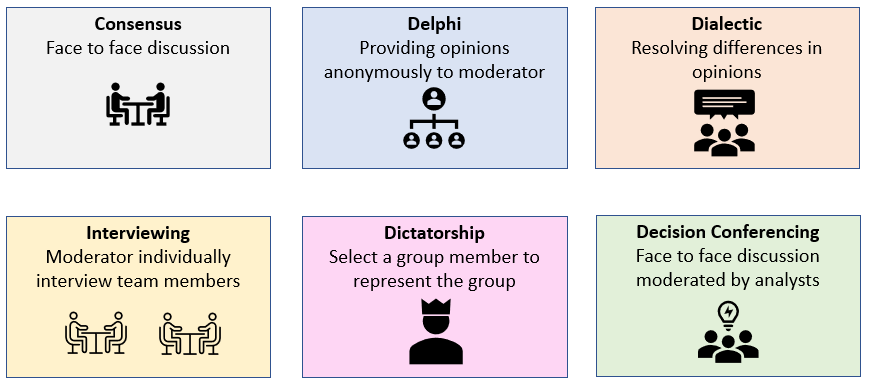In this blog, we will be looking at variety of how to incorporate groups into the risk identification process. In our book, Project Decisions: The Art and Science we covered research on how group judgment and decision-making can lead to better decisions.

Here are few techniques which can be used for risk identification:
1. Consensus
These are face-to-face discussions between group members where one judgment is eventually accepted by all members. Team members meet regularly to identify and review risks in anticipation that they will come to a consensus. However, this method has a problem, which is called “We discussed, and I decided”. This is where senior team members or managers monopolize the discussion and significantly influence the final judgment.
2. Delphi
The Delphi method named after Oracle of Delphi was developed at the RAND Corporation, a nonprofit global policy think tank, at the beginning of the Cold War to forecast the impact of technology on warfare. The Delphi process helps to protect against the “We discussed, and I decided” effect, because group members don’t meet face-to-face. Instead, they provide their opinions anonymously, perhaps on paper or some other method that ensures anonymity, in a series of rounds until a consensus is reached. The facilitator sends out a list of questions about potential risks or just asks “what risks can occur” to a panel of experts. Responses are then analyzed, and common and conflicting viewpoints are identified.
3. Dialectic.
In this technique members are asked to discuss those factors that may be causing biases in their judgments. Group members who hold differing opinions on what risks can affect the project and how will try to understand each other and resolve their differences by examining contradictions in each person’s position. For example, during the H-Bomb testing some team members may have disagreed with each other about the safety implications of certain design. It would be important to discuss these issues.
5. Interviewing.
The moderator can individually interview project experts to elicit information about risks. Many risks are related to personal issues related to different team members and management. Often these interpersonal issues are better discussed in confidence.
4. Dictatorship.
This process uses face-to-face discussions that lead to the selection of one group member whose judgment will represent that of the group. Psychologists found that judgments produced by the dictatorship technique are generally more accurate than those produced by any of the other techniques. The dictatorship technique may be useful when a project team is trying to identify risks that require specific knowledge or expertise. In this case, it is important to identify the person with the best knowledge of the subject and discuss potential risks under his or her guidance.
5. Decision conferencing.
Decision conferencing involves having experts get together for one to three days in face-to-face meetings that are moderated by a decision analyst. The analyst creates computer-based models that incorporate the risks identified by experts. We will discuss these models in later chapters of this book. The main advantage of this approach is that creation of the model goes in parallel with the discussions, so that the experts can examine the results as the discussions progress and provide a quick reality check. It is an iterative process that allows experts to identify risks and then review results of analysis and update their original assumptions if required.
6. Brainstorming techniques.
There are several different brainstorming techniques. The main goal of these techniques is to promote creative thinking among group members. These three main rules about brainstorming:
- Do not present detailed analysis of the ideas.
- All ideas are welcome, even the absolutely “far out” ideas; groups should come up with as many ideas as possible.
- Group members are encouraged to come up with ideas that extend the ideas of other members.
Psychologists have discovered that brainstorming can be more effective if several people work on a problem independently and then share and discuss their ideas. One of brainstorming techniques is called the nominal group method. At the beginning, each group member writes down as many potential risks as possible. During the meeting the members present these risks, the group evaluates them, and the moderator records result of discussion. After the discussion every group member ranks the risks. These rankings are then combined mathematically to select what risks could be used in further analysis.




